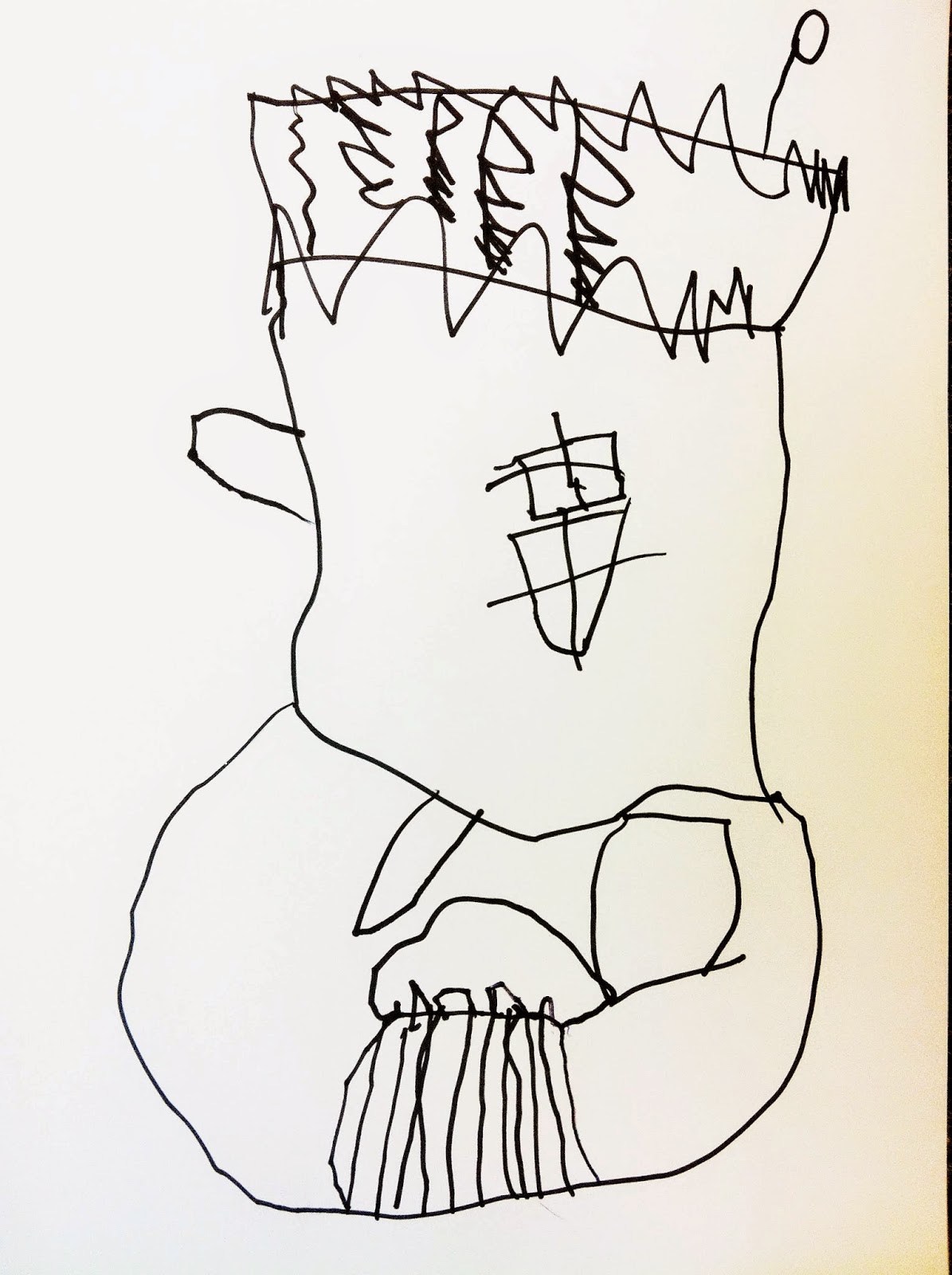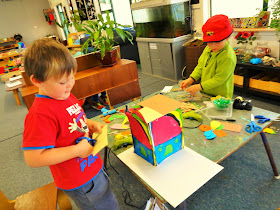Lately
I have noticed lots of different house structures being built around kindergarten.
This then lead to lots of discussions around what some of the children’s homes are
like. We reflected on what they look liked, colours, shapes, gardens etc.
With this in
mind I had found some pictures of house drawings to extend on this emerging interest. One image featured a whole variety of different magical kinds of houses with details like
cupcake doors, starry exteriors, button shaped windows and chimneys shooting
out rainbows and hearts.
The children
noticed these unusual details right away and from here we began to talk about if
we could have any kind of house in the whole entire world what it would be.
Kayden; “I would have a cupcake door
house. If you walk through the door it would taste like strawberries.”
"When patterns are broken, new worlds
emerge." -Tuli Kupferberg
The
beautiful dialogue that the children shared with each other and myself was a
great example of how free children’s ideas and thoughts can be. Their houses
didn’t have to be like anything that had seen before, they could be the shape
of flowers or smell like cupcakes. They could be coloured like a rainbow or in
the shape of a flower.
Wyatt; “You could have anything like
a rugby house, a cone house! A cone house would be so funny. Or a flower house.
You would go in the stick and the petals would be the rooms.”
Khaia; “I am going to have an Elsa
house. Elsa would live with me inside it. I might also have a Ninja Turtle
house. That would be so awesome.”
"A
child with a healthy imagination often views the world with a vivid and
engaging viewpoint. This perspective can enable a youngster to experience a
passionate childhood and grow up to be a creative and enterprising individual,
able to solve problems and find success." (Amanda Hermes)
Some of the
children decided to turn their creative thoughts into drawings. Using art to
explore and express their ideas is a great way for children to extend on their
ideas and language around the subject. In this case the more the children drew
the more dialogue was shared about their housing desires. Their imaginations came
to life the more they discussed their ideas, creating lots of joy for all
involved.
"Imagination helps children grow up to be
adults who are creative thinkers. Adults who were imaginative children often
become problem solvers, innovators and creative thinkers."
(Jamie L. Herbert)
(Jamie L. Herbert)
Payton; “My special house would have
lots of stripes of colours. My background in my bedroom would be rainbow, and
Ninja turtles and blue. When I see other houses I see no ones with lots of
colours. My house at home is white with a black house.”
Nyla; “I would love a cupcake house. My house has spot windows because I’m not sure how to draw square ones but circle ones are interesting aye. The pink window is my bedroom and my room is pink.”
Peter; “I wish I had a car house like
this one. I have wheels on it and a front door too. That’s my room. It’s bigger
for my car bed. I’ve got a car balloon too.”
“Children are all different. Each
child has unique qualities and a unique style. Some draw profusely, others
infrequently, but all constantly seek to make sense of themselves and their
world. And in this quest, it turns out that drawing is a powerful tool.”
(Kolbe)
Wyatt, "You know I have decided I want to live in an ice-cream cone house. But it will have to be an up-side down cone with the ice-cream on the top. That would be the yummy bedrooms! Man, I would just love this to be my actual house right now."
Charlie; “My house is a love heart
house. In my love heart house is my love heart room with lots of love heart
strawberries. My house is big as. I think I could maybe build this all by
myself.”
Emma, "I am drawing a few flower houses because I want so many lovely flower houses. This one has a flower person body, with a door down the bottom and up the stairs. See these are the so many stairs in my flower person house."
Sharlotte; “I have a lollie-pop house
with a leopard outside. The leopard has food. My roof would taste so good like
lollie-pops.”
Some of the
children extended their interest into creating 3D models of their houses. This
then inspired other children to create their own masterpieces. It is always so
lovely watching children discover how they can make their ideas come to life
not only through 2D art but also by turning their thoughts in structures.
Sienna; “This is my button door house
with a nest for baby birds to live in on the top. Look at my flowers and
buttons in my garden. I don’t think those are in my garden at my house. I want
to show this to my Mum and Dad.”
Tyler, "This is my rainbow chimney house with so many rainbow rooms. I have made it a garage which will have a diving board on top of it here and a car for the people who live here to drive. Its so big aye. It even has a drive way and a flower tree in the garden and another small house for friends to stay at. This has taken me so long to make, like days and days. My family will love it I think."
Emma; “My flower has me in my flower
house. I am so big because I am an adult in my house. To get in my house first
you go through the little door, you jump up on these lines and get to the windows.
I sleep right up here. It smells really nice. This is like fairy world, do you
want to live in fairy world? To get into my house you just walk up this beautiful path to the door.”
Ben, "You know that this house is going to be so tall with and ice block door. Yum, yum, yum. Would you like to come to my ice block house?"
Reese, “I just think that having a heart
door on my house would be so nice. It would be a door with lots of love for
people. My house is going to have so many treasurers hiding in it for my family
and friends. You just have to go through this special side door.”
Being able to work alongside children is such
a treasure. Their openness to thinking creatively is refreshing and such a
pleasure to be a part of. A little bit of nonsense and imagination is such a
delightful thing. I wish that one day I can visit a house with a cupcake door
that tasted sweet... the
thought of that is just so joyful.
thought of that is just so joyful.
"I like nonsense, it wakes up the brain cells. Fantasy is a necessary ingredient in living, it's a way of looking at life through the wrong end of a telescope. Which is what I do, and that enables you to laugh at life's realities." -Theodore Geisel
Ngā mihi
nui, Zair

























































